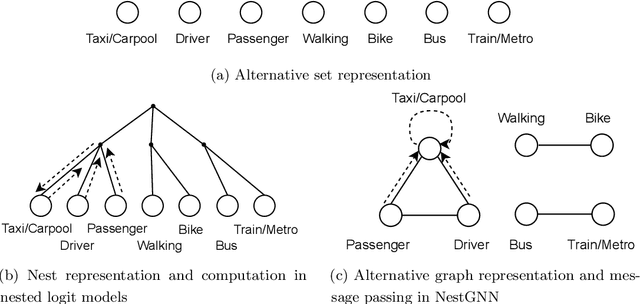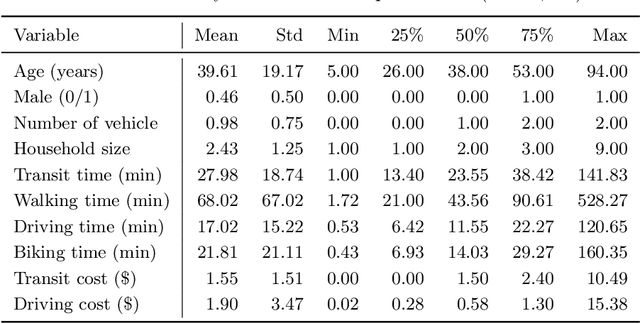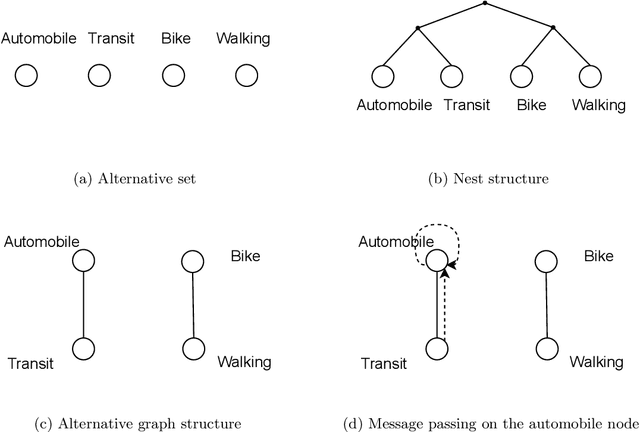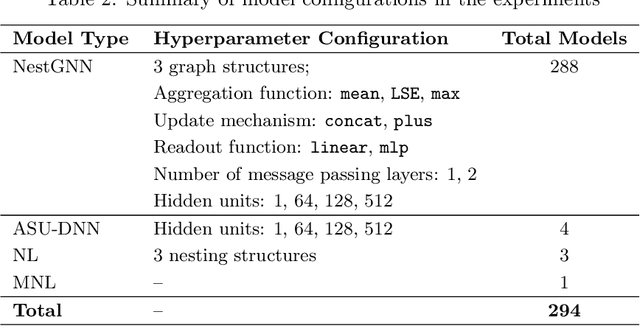Yuheng Bu
NestGNN: A Graph Neural Network Framework Generalizing the Nested Logit Model for Travel Mode Choice
Sep 08, 2025



Abstract:Nested logit (NL) has been commonly used for discrete choice analysis, including a wide range of applications such as travel mode choice, automobile ownership, or location decisions. However, the classical NL models are restricted by their limited representation capability and handcrafted utility specification. While researchers introduced deep neural networks (DNNs) to tackle such challenges, the existing DNNs cannot explicitly capture inter-alternative correlations in the discrete choice context. To address the challenges, this study proposes a novel concept - alternative graph - to represent the relationships among travel mode alternatives. Using a nested alternative graph, this study further designs a nested-utility graph neural network (NestGNN) as a generalization of the classical NL model in the neural network family. Theoretically, NestGNNs generalize the classical NL models and existing DNNs in terms of model representation, while retaining the crucial two-layer substitution patterns of the NL models: proportional substitution within a nest but non-proportional substitution beyond a nest. Empirically, we find that the NestGNNs significantly outperform the benchmark models, particularly the corresponding NL models by 9.2\%. As shown by elasticity tables and substitution visualization, NestGNNs retain the two-layer substitution patterns as the NL model, and yet presents more flexibility in its model design space. Overall, our study demonstrates the power of NestGNN in prediction, interpretation, and its flexibility of generalizing the classical NL model for analyzing travel mode choice.
UQGNN: Uncertainty Quantification of Graph Neural Networks for Multivariate Spatiotemporal Prediction
Aug 12, 2025



Abstract:Spatiotemporal prediction plays a critical role in numerous real-world applications such as urban planning, transportation optimization, disaster response, and pandemic control. In recent years, researchers have made significant progress by developing advanced deep learning models for spatiotemporal prediction. However, most existing models are deterministic, i.e., predicting only the expected mean values without quantifying uncertainty, leading to potentially unreliable and inaccurate outcomes. While recent studies have introduced probabilistic models to quantify uncertainty, they typically focus on a single phenomenon (e.g., taxi, bike, crime, or traffic crashes), thereby neglecting the inherent correlations among heterogeneous urban phenomena. To address the research gap, we propose a novel Graph Neural Network with Uncertainty Quantification, termed UQGNN for multivariate spatiotemporal prediction. UQGNN introduces two key innovations: (i) an Interaction-aware Spatiotemporal Embedding Module that integrates a multivariate diffusion graph convolutional network and an interaction-aware temporal convolutional network to effectively capture complex spatial and temporal interaction patterns, and (ii) a multivariate probabilistic prediction module designed to estimate both expected mean values and associated uncertainties. Extensive experiments on four real-world multivariate spatiotemporal datasets from Shenzhen, New York City, and Chicago demonstrate that UQGNN consistently outperforms state-of-the-art baselines in both prediction accuracy and uncertainty quantification. For example, on the Shenzhen dataset, UQGNN achieves a 5% improvement in both prediction accuracy and uncertainty quantification.
SAM2-SGP: Enhancing SAM2 for Medical Image Segmentation via Support-Set Guided Prompting
Jun 24, 2025Abstract:Although new vision foundation models such as Segment Anything Model 2 (SAM2) have significantly enhanced zero-shot image segmentation capabilities, reliance on human-provided prompts poses significant challenges in adapting SAM2 to medical image segmentation tasks. Moreover, SAM2's performance in medical image segmentation was limited by the domain shift issue, since it was originally trained on natural images and videos. To address these challenges, we proposed SAM2 with support-set guided prompting (SAM2-SGP), a framework that eliminated the need for manual prompts. The proposed model leveraged the memory mechanism of SAM2 to generate pseudo-masks using image-mask pairs from a support set via a Pseudo-mask Generation (PMG) module. We further introduced a novel Pseudo-mask Attention (PMA) module, which used these pseudo-masks to automatically generate bounding boxes and enhance localized feature extraction by guiding attention to relevant areas. Furthermore, a low-rank adaptation (LoRA) strategy was adopted to mitigate the domain shift issue. The proposed framework was evaluated on both 2D and 3D datasets across multiple medical imaging modalities, including fundus photography, X-ray, computed tomography (CT), magnetic resonance imaging (MRI), positron emission tomography (PET), and ultrasound. The results demonstrated a significant performance improvement over state-of-the-art models, such as nnUNet and SwinUNet, as well as foundation models, such as SAM2 and MedSAM2, underscoring the effectiveness of the proposed approach. Our code is publicly available at https://github.com/astlian9/SAM_Support.
Fairness Overfitting in Machine Learning: An Information-Theoretic Perspective
Jun 09, 2025Abstract:Despite substantial progress in promoting fairness in high-stake applications using machine learning models, existing methods often modify the training process, such as through regularizers or other interventions, but lack formal guarantees that fairness achieved during training will generalize to unseen data. Although overfitting with respect to prediction performance has been extensively studied, overfitting in terms of fairness loss has received far less attention. This paper proposes a theoretical framework for analyzing fairness generalization error through an information-theoretic lens. Our novel bounding technique is based on Efron-Stein inequality, which allows us to derive tight information-theoretic fairness generalization bounds with both Mutual Information (MI) and Conditional Mutual Information (CMI). Our empirical results validate the tightness and practical relevance of these bounds across diverse fairness-aware learning algorithms. Our framework offers valuable insights to guide the design of algorithms improving fairness generalization.
In-Context Watermarks for Large Language Models
May 22, 2025



Abstract:The growing use of large language models (LLMs) for sensitive applications has highlighted the need for effective watermarking techniques to ensure the provenance and accountability of AI-generated text. However, most existing watermarking methods require access to the decoding process, limiting their applicability in real-world settings. One illustrative example is the use of LLMs by dishonest reviewers in the context of academic peer review, where conference organizers have no access to the model used but still need to detect AI-generated reviews. Motivated by this gap, we introduce In-Context Watermarking (ICW), which embeds watermarks into generated text solely through prompt engineering, leveraging LLMs' in-context learning and instruction-following abilities. We investigate four ICW strategies at different levels of granularity, each paired with a tailored detection method. We further examine the Indirect Prompt Injection (IPI) setting as a specific case study, in which watermarking is covertly triggered by modifying input documents such as academic manuscripts. Our experiments validate the feasibility of ICW as a model-agnostic, practical watermarking approach. Moreover, our findings suggest that as LLMs become more capable, ICW offers a promising direction for scalable and accessible content attribution.
Defending LLM Watermarking Against Spoofing Attacks with Contrastive Representation Learning
Apr 10, 2025Abstract:Watermarking has emerged as a promising technique for detecting texts generated by LLMs. Current research has primarily focused on three design criteria: high quality of the watermarked text, high detectability, and robustness against removal attack. However, the security against spoofing attacks remains relatively understudied. For example, a piggyback attack can maliciously alter the meaning of watermarked text-transforming it into hate speech-while preserving the original watermark, thereby damaging the reputation of the LLM provider. We identify two core challenges that make defending against spoofing difficult: (1) the need for watermarks to be both sensitive to semantic-distorting changes and insensitive to semantic-preserving edits, and (2) the contradiction between the need to detect global semantic shifts and the local, auto-regressive nature of most watermarking schemes. To address these challenges, we propose a semantic-aware watermarking algorithm that post-hoc embeds watermarks into a given target text while preserving its original meaning. Our method introduces a semantic mapping model, which guides the generation of a green-red token list, contrastively trained to be sensitive to semantic-distorting changes and insensitive to semantic-preserving changes. Experiments on two standard benchmarks demonstrate strong robustness against removal attacks and security against spoofing attacks, including sentiment reversal and toxic content insertion, while maintaining high watermark detectability. Our approach offers a significant step toward more secure and semantically aware watermarking for LLMs. Our code is available at https://github.com/UCSB-NLP-Chang/contrastive-watermark.
Distributional Information Embedding: A Framework for Multi-bit Watermarking
Jan 27, 2025

Abstract:This paper introduces a novel problem, distributional information embedding, motivated by the practical demands of multi-bit watermarking for large language models (LLMs). Unlike traditional information embedding, which embeds information into a pre-existing host signal, LLM watermarking actively controls the text generation process--adjusting the token distribution--to embed a detectable signal. We develop an information-theoretic framework to analyze this distributional information embedding problem, characterizing the fundamental trade-offs among three critical performance metrics: text quality, detectability, and information rate. In the asymptotic regime, we demonstrate that the maximum achievable rate with vanishing error corresponds to the entropy of the LLM's output distribution and increases with higher allowable distortion. We also characterize the optimal watermarking scheme to achieve this rate. Extending the analysis to the finite-token case, we identify schemes that maximize detection probability while adhering to constraints on false alarm and distortion.
Image Watermarks are Removable Using Controllable Regeneration from Clean Noise
Oct 07, 2024



Abstract:Image watermark techniques provide an effective way to assert ownership, deter misuse, and trace content sources, which has become increasingly essential in the era of large generative models. A critical attribute of watermark techniques is their robustness against various manipulations. In this paper, we introduce a watermark removal approach capable of effectively nullifying the state of the art watermarking techniques. Our primary insight involves regenerating the watermarked image starting from a clean Gaussian noise via a controllable diffusion model, utilizing the extracted semantic and spatial features from the watermarked image. The semantic control adapter and the spatial control network are specifically trained to control the denoising process towards ensuring image quality and enhancing consistency between the cleaned image and the original watermarked image. To achieve a smooth trade-off between watermark removal performance and image consistency, we further propose an adjustable and controllable regeneration scheme. This scheme adds varying numbers of noise steps to the latent representation of the watermarked image, followed by a controlled denoising process starting from this noisy latent representation. As the number of noise steps increases, the latent representation progressively approaches clean Gaussian noise, facilitating the desired trade-off. We apply our watermark removal methods across various watermarking techniques, and the results demonstrate that our methods offer superior visual consistency/quality and enhanced watermark removal performance compared to existing regeneration approaches.
Universally Optimal Watermarking Schemes for LLMs: from Theory to Practice
Oct 03, 2024



Abstract:Large Language Models (LLMs) boosts human efficiency but also poses misuse risks, with watermarking serving as a reliable method to differentiate AI-generated content from human-created text. In this work, we propose a novel theoretical framework for watermarking LLMs. Particularly, we jointly optimize both the watermarking scheme and detector to maximize detection performance, while controlling the worst-case Type-I error and distortion in the watermarked text. Within our framework, we characterize the universally minimum Type-II error, showing a fundamental trade-off between detection performance and distortion. More importantly, we identify the optimal type of detectors and watermarking schemes. Building upon our theoretical analysis, we introduce a practical, model-agnostic and computationally efficient token-level watermarking algorithm that invokes a surrogate model and the Gumbel-max trick. Empirical results on Llama-13B and Mistral-8$\times$7B demonstrate the effectiveness of our method. Furthermore, we also explore how robustness can be integrated into our theoretical framework, which provides a foundation for designing future watermarking systems with improved resilience to adversarial attacks.
SAUC: Sparsity-Aware Uncertainty Calibration for Spatiotemporal Prediction with Graph Neural Networks
Sep 13, 2024


Abstract:Quantifying uncertainty is crucial for robust and reliable predictions. However, existing spatiotemporal deep learning mostly focuses on deterministic prediction, overlooking the inherent uncertainty in such prediction. Particularly, highly-granular spatiotemporal datasets are often sparse, posing extra challenges in prediction and uncertainty quantification. To address these issues, this paper introduces a novel post-hoc Sparsity-awar Uncertainty Calibration (SAUC) framework, which calibrates uncertainty in both zero and non-zero values. To develop SAUC, we firstly modify the state-of-the-art deterministic spatiotemporal Graph Neural Networks (ST-GNNs) to probabilistic ones in the pre-calibration phase. Then we calibrate the probabilistic ST-GNNs for zero and non-zero values using quantile approaches.Through extensive experiments, we demonstrate that SAUC can effectively fit the variance of sparse data and generalize across two real-world spatiotemporal datasets at various granularities. Specifically, our empirical experiments show a 20\% reduction in calibration errors in zero entries on the sparse traffic accident and urban crime prediction. Overall, this work demonstrates the theoretical and empirical values of the SAUC framework, thus bridging a significant gap between uncertainty quantification and spatiotemporal prediction.
 Add to Chrome
Add to Chrome Add to Firefox
Add to Firefox Add to Edge
Add to Edge